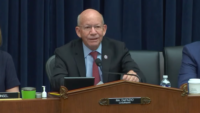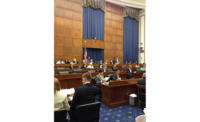The House Transportation and Infrastructure Committee has cleared a new water resources bill that would authorize an estimated $8.6 billion in federal funds to help finance 34 new Army Corps of Engineers construction projects. All of that funding is subject to annual congressional appropriations, however.
Counting the projects' nonfederal shares, ENR calculates the projects' total funding at about $13 billion.
[View text of bill here. Excludes committee-approved amendments.]
The new Water Resources Development Act, or WRDA, which the House committee approved on July 15 by an apparently unanimous voice vote, has the endorsement of top lawmakers on the committee from both parties—a rare occurrence in the current Congress, but par for the course with WRDA bills in recent years.
The next step for the legislation is a floor vote, where the measure's strong vote in committee bodes well for passage.
John Doyle, special counsel with law and lobbying firm Jones Walker LLP, praised the bill's bipartisan support. "That's the successful model for moving forward with WRDA and for that matter, with other legislation that comes out of the committee," said Doyle, a former chief of staff for the panel, when it was the Public Works and Transportation Committee.
"It strikes me as a modest bill," says Doyle, who also had been a top Army civil works official. Its funding levels are "not insignificant," he adds, "but they're well within the practice that we've seen in the past." For example, the 2018 WRDA authorized $3.7 billion for 12 Corps projects.
The largest Corps project authorization in the 2020 bill is $2.3 billion in federal funds for a $3-billion storm-protection program for the South Shore of New York’s Long Island.
Bipartisan backing
Among other provisions in the new WRDA is a priority for committee Chairman Peter DeFazio (D-Ore.), language to “unlock” the surplus in the Harbor Maintenance Trust Fund.
DeFazio says the bill would allow about $10 billion in already collected Harbor Maintenance Taxes to be used for port improvements and harbor dredging around the U.S.
Jim Walker, the American Association of Port Authorities' director of government relations, said via email, "The legislation provides an incentive for appropriators to fund greater amounts for federal navigation channel maintenance and restore channels to fully maintained condition."
For lock-and-dam projects on rivers, the legislation would increase the funding share from the Treasury's general fund to 65%, from 50% now, the Waterways Council Inc. notes. The change isn't permanent—it would apply to projects on which construction starts before the end of fiscal year 2027.
The share from the Inland Waterways Trust Fund would drop to 35%, from the present 50%. That should free more trust fund dollars for projects.
Tracy Zea, the council's new president and chief executive officer, said in a statement, "This bill is a step in the right direction for inland waterways infrastructure by adjusting the cost share to 65%/35% for seven years."
The committee’s top Republican, Sam Graves (Mo.), noted that the proposed legislation “takes vital steps to improve flood control infrastructure and reduce the future risk and potential for damage from such disasters.”
Seven of the 34 authorized new construction projects are for flood risk management; two others are combined flood protection and ecosystem restoration projects.
Big Long Island project
The Corps announced on July 10 that the Army’s chief of engineers, Lt. Gen. Todd T. Semonite, signed a report recommending the Long Island project. That put it in line to be included in a 2020 WRDA.
Sen. Chuck Schumer (D-N.Y.) said in a statement, “This chief’s report and lessons learned from [Superstorm] Sandy plot a path of resilience and mitigation we must both follow and fund.”
The total initial cost of the project, which extends from the Fire Island inlet to Montauk Point, is $1.5 billion, all of which would be federal funding.
The project also includes periodic beach replenishments, about every four years for as many as 30 years after completion.
The cost of the replenishments is an additional $1.5 billion, which would be split evenly between federal and nonfederal funds.
The project includes structure elevations and building retrofits, beach and dune fill, removal of groins and placing sediment along the bay side of the barrier island.
Senate committee's version
In the Senate, WRDA provisions are included in one of two water infrastructure bills, also a bipartisan effort, that the Environment and Public Works Committee approved on May 6. The Senate committee's version would authorize $5.1 billion for 26 Corps projects. It has yet to have a floor vote, however.
Senate committee Chairman John Barrasso (R-Wyo.) is working towards enactment of the panel's water measures and a five-year, $287-billion highway authorization that the committee approved in July 2019, committee spokesperson Sarah Durdaller said. She added, "The water bills would make a good complement to the highway infrastructure bill."
If WRDA legislation is signed into law this year, it would continue the recent practice of enacting a water resources measure every other year. WRDAs went on the books in 2014, 2016 and 2018.
In the run-up to the 2018 legislation, the House passed a bill that focused only on Corps provisions; the Senate approved a measure with Corps and EPA provisions. The enacted version included Corps and EPA sections.
Story updated on 7/15/2020 with House committee vote.




